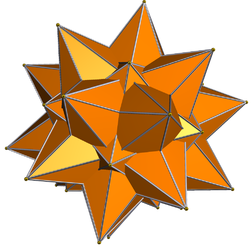| Great icosacronic hexecontahedron | |
|---|---|

| |
| Type | Star polyhedron |
| Face | 
|
| Elements | F = 60, E = 120 V = 52 (χ = −8) |
| Symmetry group | Ih, [5,3], *532 |
| Index references | DU48 |
| dual polyhedron | Great icosicosidodecahedron |

In geometry, the great icosacronic hexecontahedron (or great sagittal trisicosahedron) is the dual of the great icosicosidodecahedron. Its faces are darts. A part of each dart lies inside the solid, hence is invisible in solid models.
Proportions
Faces have two angles of , one of and one of . Its dihedral angles equal . The ratio between the lengths of the long and short edges is .
References
- Wenninger, Magnus (1983), Dual Models, Cambridge University Press, ISBN 978-0-521-54325-5, MR 0730208
External links
Weisstein, Eric W. "Great icosacronic hexecontahedron". MathWorld.





